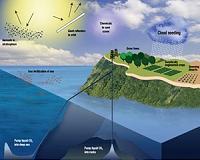 |
for Hot Zone blog Moffett Field CA (SPX) Sep 29, 2010 It's pretty well accepted among the scientific community that life existed as far back as 3.5 billion years ago. But those were days before oxygen had accumulated to significant levels.What kind of creatures were lurking an an oxygen-free world? It wasn't until 2.4 billion years ago during the so-called Great Oxidation Event that photosynthesizing cyanobacteria (blue-green algae) produced enough oxygen to saturate into organic matter and dissolved iron in the ocean and then more. The free oxygen built up in the atmosphere, killing off a huge number of these anaerobic inhabitants and making room for new species of oxygen-dependent organisms to take over. This period brought on one of the most important changes in the evolutionary history of life. was a major step in the evolution of life on Earth. But can Earth's history be so neatly divided into a world before and after oxygen? In a paper published in the journal Nature Geoscience this month, NASA astrobiology researcher Andrew Czaja writes that "whiffs of oxygen" may have been present long before the Great Oxidation Event and would match up with some early oxygen dependent fossils from long ago. Take for example a kind of manganese-reducing bacteria that might have been present nearly 3 billion years ago. To do its work, it required free oxygen to oxidize manganese. Could there have been a "local oxygen oasis"? Or were there "global oxygen pulses"? Czaja says that oxygen couldn't have been widespread at this point because even shallow surface waters were demonstrably anoxic just 200 million years later. How do you have an Ice Age and warming at the same time? As wacky as the climate patterns on Earth are right now, they've been stranger in human history.
A bipolar seesaw The last Ice Age was ending, owing to a shift in the Earth's orientation to the Sun, bringing us into the modern, temperate period that sustained the rise of civilizations. But the global warming of then was pretty a bumpy ride. There was simultaneous warming and cooling on the planet at the same time. A cold blast hit northern Europe and froze it again for another thousand years. Meanwhile, the polar South continued heating up and glaciers retreated. The Younger Dryas, named after a white flower that grows in the Arctic, was not a global event. The research, undertaken by Columbia University's Lamon-Doherty Earth Observatory, tracked the retreat of a New Zealand glacier by examining the exposed rocks, called moraines. "Whereas North Atlantic mean annual temperatures dropped drastically, by at least 15? degrees C, atmospheric temperatures in the southern mid latitudes increased during this period," the researchers write. They go on to say that a classic explanation for the variance is the "bipolar seesaw mechanism," essentially the shut-off of the Atlantic Gulf Stream that brought colder temperatures to the North and heat retention in the South. Another possible cause is a shift in the intertropical convergence zone and westerly wind patterns southwards, "which has been shown to increase Southern Ocean upwelling and outgassing of CO2 abruptly." The answer remains elusive whether rising CO2 levels alone could have caused the South to warm, or whether it needed another mechanism to move it forward, like the the bipolar seesaw. Whatever happened, it's a lesson that global warming is never the same everywhere.
Share This Article With Planet Earth
Related Links Hot Zone blog Climate Science News - Modeling, Mitigation Adaptation
 Can Geoengineering Satisfy Everyone
Can Geoengineering Satisfy EveryoneBristol, UK (SPX) Sep 23, 2010 Reflecting sunlight from the Earth by geoengineering would undoubtedly cool the climate, but would different countries agree on how much to reflect? Research by climate scientists at the University of Bristol shows that the impact of geoengineering would be felt in very different ways across the world. Previous studies of geoengineering approaches, aimed at averting dangerous climate chang ... read more |
|
| The content herein, unless otherwise known to be public domain, are Copyright 1995-2010 - SpaceDaily. AFP and UPI Wire Stories are copyright Agence France-Presse and United Press International. ESA Portal Reports are copyright European Space Agency. All NASA sourced material is public domain. Additional copyrights may apply in whole or part to other bona fide parties. Advertising does not imply endorsement,agreement or approval of any opinions, statements or information provided by SpaceDaily on any Web page published or hosted by SpaceDaily. Privacy Statement |